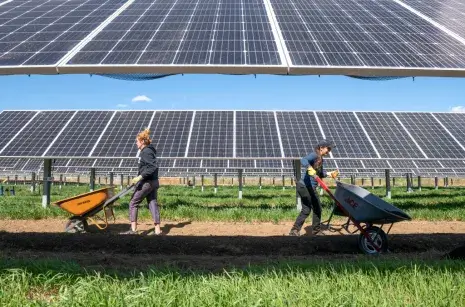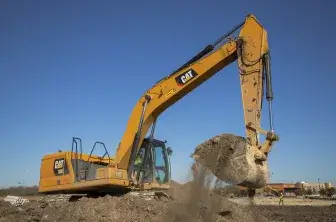Strategy 3: Mobilize Investment
Invest in Innovation

While a lot can be done with existing technology, sustained and effective action will require new technologies that can lower the cost of cutting emissions, along with novel devices and ideas to help the country adapt to impacts. The United States should have a national plan for boosting innovation, including supporting early-stage research, expanding job training, and collaborating with other countries.
Increase investment in early-stage research, development, and demonstration of new technologies.
Reassess and eliminate barriers to expanding international scientific collaborations.
Periodically evaluate the effectiveness of the U.S. investment in clean industry and climate resilience innovation.
More recommendations
Studies project that most of the emissions reductions needed can be generated by technologies that are already mature or in early adoption. However, other technologies needed do not yet exist or are still too costly to be widely deployed.[i] Clean energy technologies, such as advanced nuclear reactors, offshore wind systems in deep water, and carbon capture and storage, have been imagined but not yet demonstrated at scale in the United States. What is missing is a clear mapping of the plausible impacts of these technologies, along with stronger incentives to expand the array of potential climate-resilient innovations and develop the workforce necessary to realize rapid expansion. Together, this will lower the cost of climate action, enabling pragmatic, just, and accountable investments in climate action.
Increase investment in early-stage research, development, and demonstration of new technologies.
Significant funding has been made available through the Infrastructure Investment and Jobs Act (IIJA) and Inflation Reduction Act. The CHIPS and Science Act may also lead to substantial funding for climate-related technologies. The private sector and philanthropy must also sustain and expand funding for frontier technologies and research.
New technologies are intrinsically uncertain, making them less appealing for private sector investment in the absence of public policy incentives. Therefore, an important priority must be reducing the financial risk to investors that want to deploy novel technologies but are unwilling or unable to absorb all the risks themselves.
The Commission does not take a position on the exact level of funding that government or philanthropy should invest. Experts’ assessments of the appropriate expansion of public sector support for new technologies range from doubling to tripling current investments, or increasing by even larger ratios.[ii] A greater combination of resources and funding would deliver value to American society through cutting emissions and providing jobs. The U.S. government has long performed this role through the national laboratories, the DOE loan programs office, the Advanced Research Projects Agency for Energy, and others.[iii]
Later-stage prototypes will need support from blended finance models that combine government and private investment. Recent legislation provides support for clean energy technologies, although the longest-lasting provisions tend to be subsidies for mature technologies while the provisions for the most innovative technologies will expire too quickly. Boosting innovation and testing new technologies for the long term requires the extension of funding beyond these programs’ projected expirations in five to seven years. And while there has been substantial support for innovation related to emissions reduction and control, much less is dedicated to novel technologies that could improve the nation’s resilience to the impacts of climate change.
Reassess and eliminate barriers to expanding international scientific collaborations.
It is imperative that the U.S. national system of innovation remains strong and effective. That system relies on international students at American universities, collaborators around the world, and innovators from abroad who start companies in the United States.[iv] Burdensome visa processes, overclassification, and mistrust between nations impede the flow of scientists across borders and harm the pace and quality of scientific achievement. While the American public is often reluctant to commit to overseas relationships, the United States must nevertheless maintain international connections for the benefit of the laboratories, universities, and companies that are the engines of American innovation.[v]
Periodically evaluate the effectiveness of the U.S. investment in clean industry and climate resilience innovation.
Innovation is intrinsically steeped in uncertainty, about the sources of new technologies, how market demand affects that supply, and the effectiveness of various policy instruments. Thus, the United States must periodically evaluate the efficacy of its national policy strategies for technological development and deployment. That evaluation must focus on innovation around emission controls and efforts to improve resilience. With input from the Office of Management and Budget and other arms of the government that address these issues such as the Congressional Budget Office and Office of Science and Technology Policy, evaluations can ensure that funds are spent efficiently, effectively, and ethically. These reviews should be done by independent, specialist organizations and funded by the government or private philanthropy.
[i] Rory Clune, Laura Corb, Will Glazener, et al., Navigating America’s Net Zero Frontier: A Guide for Business Leaders,” McKinsey Sustainability, May 5, 2022, https://www.mckinsey.com/capabilities/sustainability/our-insights/navigating-americas-net-zero-frontier-a-guide-for-business-leaders.
[ii] Rebecca Henderson and Richard G. Newelll, Accelerating Energy Innovation: Insights from Multiple Sectors (Chicago: University of Chicago Press, 2011).
[iii] U.S. Department of Energy, “Advanced Research Projects Agency Energy (ARPA-E),” May 8, 2023, https://www.energy.gov/advanced-research-projects-agency-energy-arpa-e.
[iv] American Academy of Arts and Sciences, America and the International Future of Science (Cambridge, Mass.: American Academy of Arts and Sciences, 2020), https://www.amacad.org/publication/international-science; American Academy of Arts and Sciences, Bold Ambition: International Large-Scale Science (Cambridge, Mass.: American Academy of Arts and Sciences, 2021), https://www.amacad.org/publication/international-large-scale-science; and American Academy of Arts and Sciences, Global Connections: Emerging Science Partners (Cambridge, Mass.: American Academy of Arts and Sciences, 2022), https://www.amacad.org/publication/international-emerging-science-partners.
[v] Pew Research Center, Public Uncertain, Divided Over America’s Place in the World (Washington, D.C.: Pew Research Center, 2016), https://www.pewresearch.org/politics/2016/05/05/public-uncertain-divided-over-americas-place-in-the-world/; and E. William Colglazier, “The Precarious Balance Between Research Openness and Security,” Issues in Science and Technology 39 (3) (2023), https://doi.org/10.58875/PVVJ5251.






